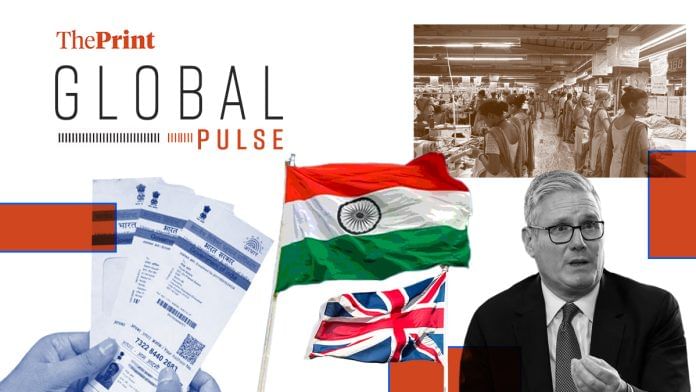New Delhi: Now in the final leg of his two-day visit to India, UK Prime Minister Keir Starmer has given the Aadhar card his seal of approval, calling the identification system a “massive success”.
Starmer “shrugged off criticism” and said that an equivalent system could serve as “good ID cards” for British citizens, Jim Pickard and Krishn Kaushik report in the Financial Times.
“There is a case to be made about the benefits of voluntary ID into other areas, and obviously we need to make that case,” FT quoted Starmer as having said. Starmer added, “I don’t know how many times the rest of you have had to look in the bottom drawer for three bills when you want to get your kids into school or apply for this or apply for that, it drives me to frustration.”
On Tuesday, the British prime minister also held talks with Nandan Nilekani, hailed as the ‘architect’ behind the unique 12-digit ID.
“The prime minister’s spokesperson said digital ID cards in Britain could be used on a voluntary basis for easier access to services including welfare, childcare and driving licenses,” says the report. Adding, “It comes as more than 2.8mn people have signed an online parliamentary petition against the introduction of digital ID cards in the UK.”
The report also makes note of the legal challenges to Aadhaar.
“The country’s supreme court has struck down petitions challenging the project. However, it has restricted its mandatory use to largely welfare schemes, helping curtail corruption and fraud. Activists, though, continue to highlight that biometric authentication using Aadhaar has led to some of the most marginalised being excluded from accessing welfare benefits at times,” read the FT report.
In September 2018, the Supreme Court of India while upholding the constitutional validity of the Aadhaar Act, struck down certain provisions as unconstitutional.
The Economist’s Essential India newsletter, written by its Asia correspondent Leo Mirani, also looks at an India-UK comparison routed by way of the Aadhaar.
“Britain today is where India was two decades ago, when dealing with the state or even private companies usually involved producing one or several documents from a list as long as your arm. Then came Aadhaar, a biometric ID system that is now used by nearly every Indian,” says the newsletter.
Britain is currently in the throes of setting up its own unique ID system. It can learn from India where now, getting by without an Aadhaar card is impossible, writes Mirani. “This created resentment and suspicion that has never fully dissipated. If Britain wants its ID system to be popular, and to avoid long legal challenges, it should be upfront about its many possible purposes, and clear about where it draws the lines,” he says.
Another significant lesson is one of exclusion. India continues to be bogged down by reports of denial of government services on account of “technical glitches” in the Aadhaar database.
“Even today, Aadhaar is dogged by reports of rightful beneficiaries being denied benefits because of technical glitches. At the same time fears are growing in some states that those without a right to the ID are acquiring it anyway. A system that denies legitimate claimants while permitting interlopers is not doomed to failure. But nor can it be said to be a true success,” Mirani adds.
Then there is the surveillance state concern.
“Aadhaar again provides the example. Far from being folded into some omniscient national database, it has instead become a template for dozens of unnecessary, wasteful ID programmes rolled out by other government departments. That, then, is the final lesson of Aadhaar for Britain: success can bring its own problems too,” says The Economist newsletter.
Factory workers in Panipat, the “cast-off capital of the world,” are bearing the brunt of an unyielding, international market, as they turn discarded clothing items into yarn that is woven into “rugs, throws and sheets for international retailers,” reports Anuj Behal in The Guardian.
“Nearly six years ago, Devi left Hardoi, a town 300 miles away, and came to Panipat with her husband, lured by the promise of steady mill work. Today, she works six days a week, often with her young sons by her side due to the lack of on-site childcare facilities. But the clothes she recycles each day are making her sick. The coughing lingers long after she leaves the factory, and visits to the doctor have become routine,” says the report, which contains worker testimonies.
“The doctor tells me it’s because of all this dust I breathe every day,” she tells The Guardian. “He gives me medicine, but it only works while I take it. Once I stop, the coughing comes back. He says I should leave this work. But I can’t afford to.”
“Panipat recycles approximately 1 million tonnes of textile waste annually through its 20,000 industrial units and a workforce of at least 300,000, diverting large volumes of discarded textiles that might otherwise end up in landfill worldwide,” says the report, spotlighting damning statistics.
(Edited by Amrtansh Arora)
Also Read: India stands out as renewables overtake coal; ‘striking growth’, says global media






